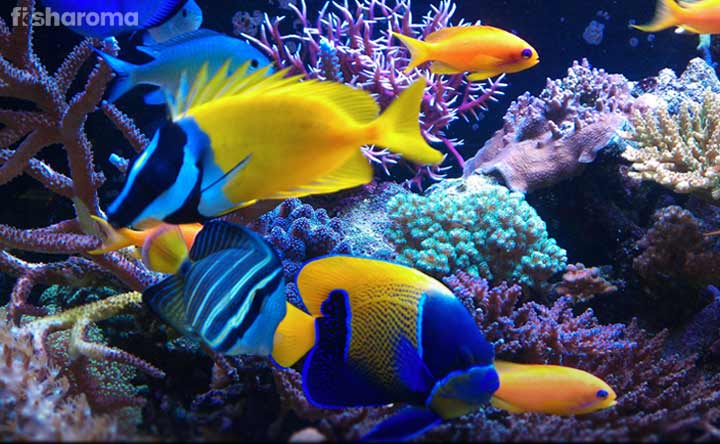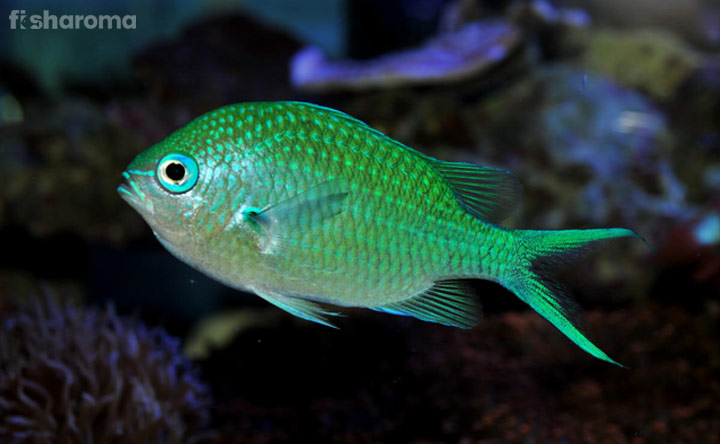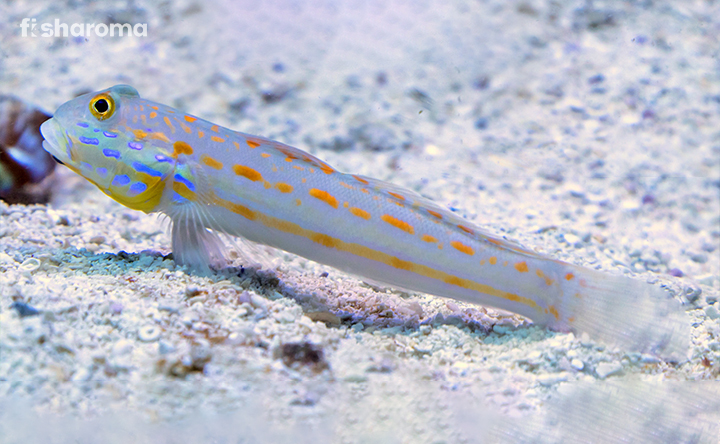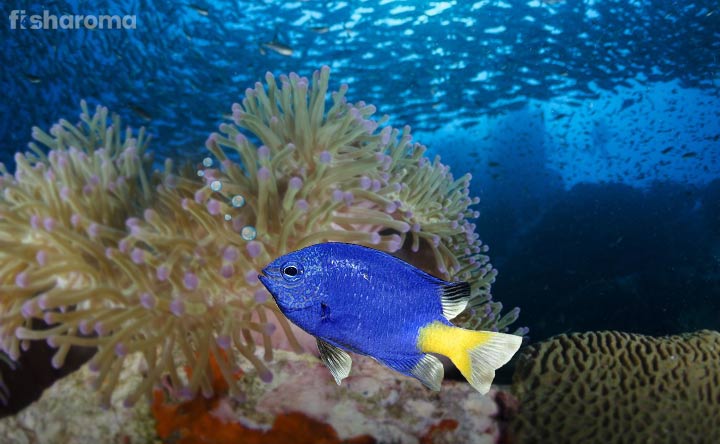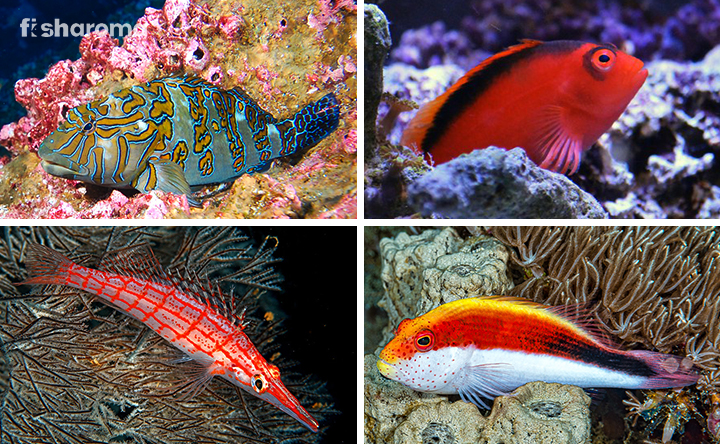Emperor Angelfish – The Complete Care Guide

- Origin & Habitat of Emperor Angelfish
- Appearance of Emperor Angelfish
- Behaviour of Emperor Angelfish
- Lifespan of Emperor Angelfish
- Diet of Emperor Angelfish
- Tank Requirements for Emperor Angelfish
- Water Type for Emperor Angelfish
- Compatibility of Emperor Angelfish
- Breeding of Emperor Angelfish
- Emperor Angelfish Diseases
- Difficulties in Petting Emperor Angelfish
- Summary
One of the most sought-after saltwater aquarium fish, the Emperor Angelfish are known for their shimmering colors, unique patterns, and gracious flat bodies. These qualities, in addition to the fact that they are rarely available, make them extremely expensive.
Besides, they are not easy to take care of. But that hasn’t stopped pet lovers from having them in their aquarium. And it shouldn’t stop you also. Because we are here to help you understand how to work your way around this beautiful creature and pet them at your home.
Key Specifications of Emperor Angelfish
Before we get into the details, take a sneak-peek at some of the key specifications of Emperor Angelfish from the table below.
| Scientific Name | Pomacanthus imperator |
| Family | Pomacanthidae |
| Origin | Coastal East Africa |
| Size | Up to 12” (30.48 cm) |
| Color | Yellow, Blue |
| Care Level | Difficult |
| Lifespan | 20+ Years |
| Temperament | Semi-Aggressive |
| Compatibility | Low |
| Tank Size | 125-Gallons |
| Diet | Omnivore |
Overview
Emperor Angelfish is a species of marine Angelfish and a member of the Pomacanthidae family. Found in the Indo-Pacific Ocean, they are a reef-associated fish. Both the juvenile and adult form of this fish are popular since each of them come with their set of attractive features. Even the sub-adult (intermediate) stage that comes between these two stages has its own unique look.
Emperor Angelfish also acts as a cleaner fish. It is one of the very few saltwater reef animals that don’t face extinction. They are also a favorite subject for marine photographers due to their aesthetics.
Origin & Habitat of Emperor Angelfish
The origin of the Emperor Angelfish is in the coastal regions of East Africa from the Pacific Ocean to the Indian Ocean. They can be found in the Red Sea in Hawaii and the Austral Islands. They have also been spotted in the Great Barrier Reef, southern Japan, New Caledonia, Florida, and Puerto Rico. In recent past, it has been noted that they have been colonizing the southeast Mediterranean via the Suez Canal, most likely as an invader.
Juvenile Emperor Angelfish are found under ledges and in holes of semi-protected channels, outer lagoon reefs, and outer reef flats. The sub-adults inhabit surge channels and reef front holes, whereas the adults can be seen under ledges, in caves rich in coral reefs, in channels, in seaward reefs, and in lagoons.
They usually live at a depth of 1 to 80 m (3 – 262 ft).
Appearance of Emperor Angelfish
As we have stated above, they are extremely pleasing to the eyes. Much of that is attributed to their color and patterns, which we will get into here, but first, let us try and understand their other physical features.
Emperor Angelfish are deep-bodied fish that are a bit elongated. They also come with strong, bulky jaws that help them chew up sponges. Their digestive tract helps coat the food with a mucus layer that protects their gut from sharp silica of the sponges.
They have prominent dorsal, pectoral and caudal fins over their oval-shaped body. In male Emperor Angelfish, the frontal portion of their eye mask is blue in color, while in females, it is grey-blue in color. This is one way of determining their sex.
Throughout their lifetime, they go through massive physical transformations, not only in size but also in colors.
Size of Emperor Angelfish
The size of a juvenile Emperor Angelfish ranges from 1-3” (2.5 – 7.6 cm) while the sub-adults grow up to a length of 3-4.5” (7.6 – 11.4 cm). In their matured state, an adult Emperor Angelfish grows to a length of 4.5-12” (11.4 – 30.4 cm).
Color of Emperor Angelfish
One of the magnificent features of an Emperor Angelfish is that they change their color throughout their lifetime, mainly in three separate phases. The three phases are juvenile, sub-adult and adult.
The first phase is the infant stage. A juvenile Emperor Angelfish has a blue and/or black body with vertical lines in white and light blue running all across their face. There are three thicker white bands behind their gill areas. The first of these three bands is a curved shaped band that extends from their dorsal fin to their caudal fin.
The second one is a ‘C’ shaped band while the third one forms a white circle near their caudal fin. In between these white bands, there are thin light blue bands. There is a honeycomb pattern over the dorsal and caudal fin, along with a white top-edge to their dorsal fin.
When the Angelfish enters their sub-adult stage, their tail fin starts developing a yellowish pattern. Vertical dashes start appearing on their body too that blends perfectly with the juvenile pattern. The shape of their body also becomes rounder in this stage.
In the final adulthood stage, there are blue and yellow horizontal lines all across their body. They start from the end of their gills to the start of their tail fin, which is completely yellow in color. The top dorsal fin has a touch of white trim to it. The bottom dorsal fin is blue in color and sometimes has light blue stripes on them. There is a mast-like black band across their eyes with a blue trim. Their mouth and snout are white in color.
When an Emperor Angelfish is kept in captivity, the changes in their colors can be delayed. This is primarily because they are not in their natural habitat and don’t have access to essential natural nutrients that are only available in the wild.
Behaviour of Emperor Angelfish
Emperor Angelfish are seen alone, in pairs and even in trios or harem of one male and two or more females in the wild.
Extremely shy in nature, they are slow at adjusting to captive life. They love to hide and retreat. Adult Emperor Angelfish are known to nip at soft and stony corals and clam mantles, although they do not harass small Polyp Stony Corals (SPS).
They are territorial in nature and get defensive when they feel that their space is being claimed by other beings. Although they may seem shy when they are introduced for the first time in the tank, they tend to become active as time progresses.
Lifespan of Emperor Angelfish
An Emperor Angelfish can live up to 20 years in the wild. However, when they are kept in captivity, they generally live up to 15-18 years.
Diet of Emperor Angelfish
Omnivorous by nature, Emperor Angelfish feed on both plants and small invertebrates. Their primary diet consists of algae and sponges. You need to provide them with a diet that is rich in vitamins. Color enhancing food is also said to help them with coloration issues. They basically need a balanced diet of meaty foods, vegetables and sponge material to thrive healthily. However, finding a sponge is a bit of a task.
A proper healthy diet of an Emperor Angelfish should consist of the following:
- Marine Algae
- Spirulina
- Dried Flake
- Frozen Meaty Food
- Cockles
- Scallop
- Brine Shrimp
- Mussels
- Squid
- Spinach
- Tunicate
- Hydroid
- Bryozoan
- Krill
- Mysis
They tend to become aggressive during feeding and may attack other fish in the tank if they feel that there is not enough food. Thus, always make sure that there is enough food for everyone in the tank.
Beware of overfeeding them as that is one of the biggest reasons for poor water quality. Remove any leftover food immediately in order to ensure the water remains clean.
They usually take time to get used to home food. Although initially, you can feed them five times a day, lowering the quantity when they get used to the home food is a good idea. Make the transition smooth and slow. From there on, feeding them 2-3 times in a day in moderate quantity is advised.
If a proper diet is not maintained, their colors will start fading.
It is recommended to raise an Emperor Angelfish from a juvenile stage. This is because it will be easier for them to adjust to dry and frozen food if they are fed those from an early stage of their life. Adult Emperor Angelfish can’t all of a sudden change their food habits from live food to dry, frozen food.
Tank Requirements for Emperor Angelfish
Now we all know that maintaining a healthy tank is essential for the longevity of your fish. We have to keep a number of factors in mind such as how large the tank should be or what kind of filter you should and should not install in it, whether you need to cover the lid of your tank or not and based on the fish that lives in your tank whether you should keep any ornaments and plants in there or not.
Bear in mind the following aspects while setting up the tank for your Emperor Angelfish.
Tank Size
One of the most challenging aspects of petting an Emperor Angelfish is the sheer amount of space they need. Your tank must be able to accommodate at least 125 gallons of water if you are planning to pet a single Emperor Angelfish. If you are planning to keep a pair of them, then it should be at least 180 gallons. Mind it; this is the ideal size for a juvenile Emperor Angelfish.
In their adulthood, the size of the tank may go up to 220 gallons per fish. They are known to eat a lot of food. As a result of which there a huge bi-load on your tank. Naturally, if you keep a small tank, it will foul quickly.
Nature of Lighting
The next major component that you need to keep in mind is the lighting of your aquarium. Emperor Angelfish requires proper and bright lighting to live healthily. Not only will it help in their coloration process, but it will also help prevent head and lateral line erosion diseases. Reef-like lighting is also recommended since that would mimic their natural habitat.
Tank Lid
Keeping a tank lid is not mandatory here since Emperor Angelfish are exactly not known for jumping and leaping out of the water. But, if your house has other pets such as a cat or dog or even has small children, it is recommended that you keep a lid on your tank since it will ensure the safety of your fish.
Filter
Emperor Angelfish requires a good filtration system since they have a reputation for producing a lot of waste. They also need strong currents to survive. Therefore, look for a filter that will not only ensure that the quality of the water is maintained, but also be able to emulate the natural water conditions of an Emperor Angelfish. Also, make sure that the oxygenation level of the water is maintained round the clock.
You can also equip your tank with a protein skimmer and a UV sterilizer. They would also help regulate the quality of the water inside the tank, thereby creating a healthy environment for your pet.
Ornaments
As we have mentioned above, Emperor Angelfish love to hide. If you can manage to find live rocks, then there’s nothing like it, because this is what Emperor Angelfish love. They love to nip at live rocks and eat them. However, in the absence of it, you can always buy artificial aquatic caves, rocks, and pebbles.
Make sure the cave doesn’t have any sharp edges or pointed cones since that may injure your pet. Hiding spots are crucial for ensuring their comfort since they spend most of their time in the wild taking refuge in the corals and rocks. Try to arrange the rocks in a manner that helps them hide in them.
Presence of Flora
Keeping plants will further enhance the environment. Not only will they look good, but they will also help your pet feel that they are living in the wild.
Now we know that maintaining natural plants can be tricky since they need a lot of care and maintenance. But think about it, a plant can be a natural source of oxygen for your fish. So, it will work as a natural oxygenation filter. However, in case you want to go with an artificial plant, make sure that they are made of non-toxic material and don’t have sharp edges.
After setting up the tank, the next line of work is deciding upon what kind of water you need to provide for your Emperor Angelfish. Let us now take a quick look into that.
Water Type for Emperor Angelfish
First and foremost, since Emperor Angelfish is a saltwater fish, you just can’t fill up your tank with tap water. You can either buy saltwater from your nearest pet store or you can buy sea salt and mix them to your water.
After this, you have to keep the following things in your mind:
Temperature
Emperor Angelfish prefer living in relatively warmer water. The temperature of the water should be 72-78° F (22-25° C). However, don’t keep the temperature more than this since it may burn the skin of your pet. Keeping a thermometer installed in your tank will help you monitor the temperature of the water in your tank.
pH Level
The ideal pH level of the water that houses Emperor Angelfish should be 8.1-8.4.
Gravity
The gravity of the water must be 1.020-1.025.
Hardness
The Carbonate hardness of the water in your tank should be 8-12 dKH.
Replacement Procedure
Compared to most other saltwater aquarium fish, the Emperor Angelfish is known to dirty the water around them more. As a result, the chances of your fish becoming sick are high if you don’t maintain the proper quality of the water.
You can choose to replace the water of your tank on a monthly or a bi-weekly basis. If you choose the monthly routine, then replace 30% of the tank water every month. Else, If you decide to opt for a bi-weekly method, replace 15% of the tank water every 15 days.
If your tank has corals, then you should replace 5% of the water every week, or 10% of the water every two weeks, or 20% of the water every month. Do not replace all of the water at once since it will eliminate all the beneficial bacteria from the water and also bring a sudden change to the environment that your fish may not like.
Compatibility of Emperor Angelfish
Although in the wild, Emperor Angelfish are sometimes seen in pairs and trios, the situation changes dramatically when they are kept in captivity. The stress caused by the small space (no matter how big your tank is, it will never be able to replicate the vastness of the wild) makes them more territorial and defensive towards their own kind, especially during feeding time.
An adult Emperor Angelfish can be kept with a juvenile Emperor Angelfish. However, when the juvenile goes through color changes, the adult becomes quite intolerant. So, it is advised to keep them separate when the change in coloration takes place.
Suitable Tankmates for Emperor Angelfish
An Emperor Angelfish should always be the last one to be introduced to a fish tank as this will help avoid them to establish their own territory over the water space. The following is a list of fish that you can keep with an Emperor Angelfish.
- Butterflyfish
- Boxfish
- Anthias
- Chromis
- Damsels
- Clownfish
- Pufferfish
- Squirrelfish
- Parrotfish
- Lionfish
- Groupers
- Cleaner Wrasse
- Surgeonfish
- Tangs
However, it is still advised to monitor the behavior of the Emperor Angelfish when they are kept with another fish species.
Unsuitable Tankmates for Emperor Angelfish
They have the tendency to harass small peaceful fish. Also, if they are kept with fish that are relatively small, they may eat them up. The species of fish that you should avoid keeping together with an Emperor Angelfish are as follows:
- Seahorse
- Pipefish
- Dartfish
- Filefish
- Large Angels
- Gobies
- Jawfish
- Live Corals
- Sharks
- Triggerfish
- Pseudochromis
Breeding of Emperor Angelfish
Breeding of Emperor Angelfish in captivity has not been possible as of yet. Successful breeding has only been accomplished in extremely large display aquarium. It is almost impossible to keep such a large aquarium by home aquarists.
Emperor Angelfish generally spawn only once a year. Spawning refers to the release of eggs or sperm by an aquatic animal. The male and female Emperor Angelfish circle each other after ascending in the water column. At the pinnacle of their accent, both of them release eggs and sperm at the same time.
The larvae continue to float in its planktonic stage for a couple of weeks before turning into fry, which slowly develops into their juvenile form (fry refers to a young, small fish). Keeping the larvae on the water surface also saves them from bottom-dwelling predators in the reef.
Emperor Angelfish Diseases
In their adult form, they are often attacked by parasites. Therefore, a proper quarantine method should be followed.
If proper tank conditions are not maintained, they may suffer from stress, which may cause White Spot Disease or Saltwater Ich. The symptoms of this disease are constant scratching and the appearance of white dots all over their body. The dots disappear for a couple of days, only to return with twice the amount. The fish generally suffers from suffocation from these parasites when they cover their gills.
Another dangerous ailment is the Marine Velvet, which is also a parasitic skin flagellate. Its symptoms are respiratory distress, clamped fins, weight loss, cloudiness of eyes and glancing off décor or substrate. Respiratory distress can be noted by rapid unusual gill movements. It also results in the appearance of a peppery coat that gives a yellow to light brown ‘dust’ on their body.
In case of a parasitic attack, consult medical help. One immediate solution is to increase the temperature of the water to 82° F (28° C). This will stop the parasites to attach themselves to the fish.
Difficulties in Petting Emperor Angelfish
Emperor Angelfish are difficult to maintain. These saltwater species are prone to suffer from stress in a captive environment, especially if the tank size is not large enough.
They are also not reef safe since they nip anemones, soft corals, zoanthids, Large Polyp Stony Corals (LPS) and clams. Only when you have a huge fish tank, you may keep small Polyp Stony Corals (SPS) and few noxious soft corals. If your fish is well fed, chances are there that they won’t attack them.
They also take time to adapt to frozen and dried food and are territorial in nature. Breeding is also impossible in captivity.
Interesting Facts about Emperor Angelfish
- Emperor Angelfish were first identified in the year 1787.
- They are also known as Imperial Angelfish and Imperator Angel.
- When they feel threatened, they make a grunting sound.
- Until 1933, the juvenile Emperor Angelfish was thought to be a separate species.
- The Sri Lanka-Emperor Angelfish has been noted to have the brightest colors in captivity.
Summary
The beauty of an Emperor Angelfish can’t be denied. The graciousness of their flat body and their eccentric movement makes them a treat for your eyes. However, they are not easy to maintain and can get quite aggressive when they are hungry or when they feel their space is being invaded by others. It is an excellent addition to your aquarium but will demand an expert’s care, especially to regulate the condition of the water.
Similar Variants of Emperor Angelfish
Species of fish that bears the same characteristic features of an Emperor Angelfish are as follows:
- French Angelfish: Found in the Atlantic Ocean, the juveniles of this fish serve as cleaning fish. They are monogamous and oviparous in nature.
- Queen Angelfish: Always seen in pairs, the females can release up to 10 million eggs during each cycle of spawning.
- Barred Angelfish: Barred Angelfish are known to live in harems of one male and multiple females. And their mating ritual is one of the longest in the aquatic world.
- Bellus Angelfish: A feature of Bellus Angelfish that makes them unique is their pearlescent body, meaning their body seemed to be of different colors when they are viewed from different angles. They grow up to a length of 6” (15 cm).

